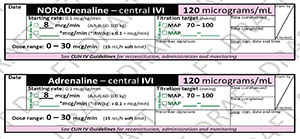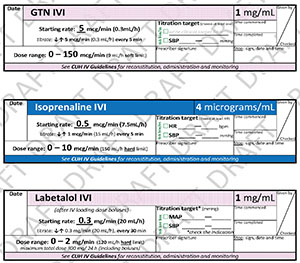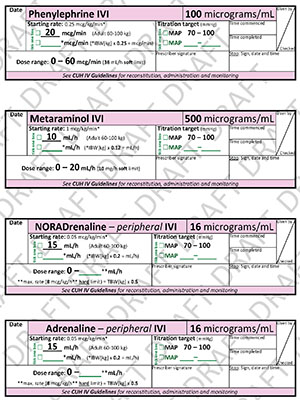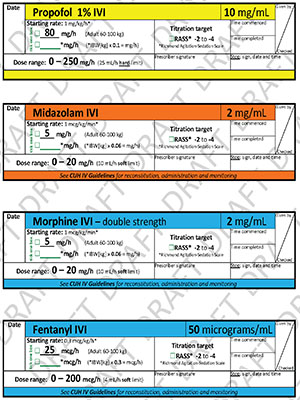Purpose Statement
Prescription stickers have been created for continuous infusions of vasoactive and sedative medications in CUH Emergency Department.
All these medications are for careful titration at the bedside until clinical stability is achieved, they are not 'set and forget'. The stickers are designed to increase efficiency and reduce delay/ distraction, whilst also providing key clinical guidance.
They are for use within Cork University Hospital ED only, covering only the medications in the following stickers (see below).
Standard medication names are used, abbreviations match those used on Braun Perfusor syringe driver/ Braun Informat pumps.
Standard colours are used to demarcate drug classes as per drug labelling stickers already in use in CUH and internationally.
- DS = double strength
- GTN = glyceryl trinitrate
- IVI = intravenous infusion
- MAP = mean arterial pressure
- SBP = systolic blood pressure
Pump limits (Soft and Hard)
Soft limit refers to usual upper limit of infusion dose rate which may sometimes by exceeded when clinical need cannot be met otherwise. The Hard limit is the absolute reached at which point no further rate increases are allowed by the Braun driver/ pump.
In these stickers, soft limits for maximum infusion rate are used unless not available, where hard limits are then used. This is to ensure that patients reaching these soft limits are identified early and have reassessment of care, including review by senior clinicians.
CUH IV guidelines
Individual monographs are hosted together at https://emed.ie/Pharmacology/IV_Admin.php.
Prescription is completed in standard way with prescriber signature and date.
The sticker is designed to be valid until such time it's cancelled (like any prescription). Critical care medication infusions are different to other prescriptions in that it's a single drug at variable rate with dynamic physiological target, and also includes a rate of zero- i.e. being ceased once target is reached.
It is very unlikely that any patient on these critical care infusions would remain in ED beyond 24 hours however, if so, then the prescription should be reviewed and renewed.
Procedure
- Stickers are kept on a rack opposite resus 4
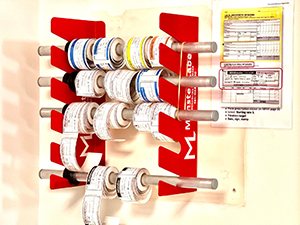
- Stickers are sized to fit within the MPAAR drug chart within the 'Continuous drug infusions' section (pg. 21)
- Prescriber should choose appropriate prescription sticker, place over one box in this area, and choose one of two starting options: either tick general safe starting rate for most adults (60-100 kg), calculated based on median total body weight of 80 kg; or precisely prescribe based on measured patient weight (Ideal Body Weight, IBW, is used for accuracy and is easier to ascertain than Total Body Weight in critically ill patients – height & sex)
- We recommend using a validated web calculator e.g: https://www.mdcalc.com or NCHD.ie
- Calculations have been rounded to whole numbers for simplicity. It must be remembered that the starting rate is just that – it will be titrated within minutes until physiological parameters are acceptable, as per usual clinical practice
- Clinical targets are recorded in order to guide infusion adjustments, which are different for each medication and clinical situation. Standard clinical targets are used. MAP is preferred for BP but some clinical guidelines still refer to SBP, so this is provided
- The sedation target employed is the Richmond Agitation-Sedation Scale (RASS)
Links
References
- CUH Critical Care IV Guidelines and CCU Infusion Guidelines
- BNF via Medicines Complete
- CUH Children's Resuscitation Book ('CRB') – NB this is written for children but includes weights up to 80 kg
- CUH Braun drug library (Perfusor driver & Informat pump)
- https://medinfogalway.ie/ivguides
- https://cardiffcriticalcare.co.uk/wp-content/uploads/2020/11/Metaraminol-ICU-SOP-028.pdf
- https://smh-gas.org.uk/wp-content/uploads/2021/03/Metaraminol-Peripheral-Infusion-Guideline-4.0-final-version.pdf
- Natalini G, Schivalocchi V, Rosano A, et al. Norepinephrine and metaraminol in septic shock: a comparison of the hemodynamic effects. Intensive Care Medicine 2005; 31(5):634–637
- IAEM Clinical Guideline: The use of Vasopressor Agents by Peripheral Intravenous Infusion in Adult Patients in the Emergency Department. Version 1.0. February 2024
| +4 | Combative |
|---|---|
| +3 | Very agitated |
| +2 | Agitated |
| +1 | Restless |
| 0 | Alert and calm |
| -1 | Drowsy |
| -2 | Light sedation |
| -3 | Moderate sedation |
| -4 | Deep sedation |
| -5 | Unarousable |
